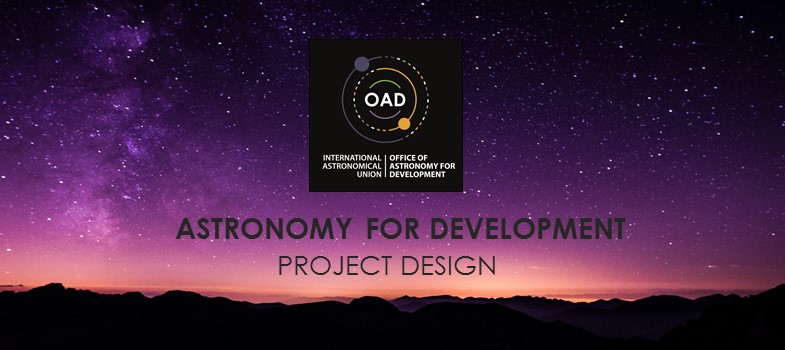Theme 1: Sustainable, Local Socio-Economic Development through Astronomy
A brief description of the flagship project theme 'Sustainable, local socio-economic development through Astronomy' and examples of past projects with interventions ran under this theme
Astronomy is generally seen as a “luxury” science that only high-income countries can afford. It is often believed that it is a science that requires expensive infrastructures, and is of no use for economically disadvantaged countries, especially the many African countries that face socio-economic challenges. For this reason, astronomy very often appears as a low-priority science. However, the unique ability of astronomy to stimulate curiosity in the minds of young children and adults alike, as well as imagining possibilities, gives it a special place among the efforts to address development challenges.
In the hope of changing the current perspective and using astronomy as a tool to contribute to socioeconomic development in the world and particularly in underdeveloped countries, the International Astronomical Union’s Office of Astronomy for Development (IAU-OAD) has funded several projects that aim at addressing some of the development challenges.
This section provides background information, lessons learned from past projects, and guidelines for anyone planning to run interventions under Sustainable Local Socio-Economic Development Through Astronomy‘ flagship theme.
Examples of Past Projects
The past projects funded by or conducted in collaboration with the OAD have generally shown to improve the socioeconomic development status of the targeted populations. In this section we summarise a few examples of local socio-economic impacts of community projects conducted either by organisations in partnership with the OAD, or observatories around the world.
1) With the construction of the large SALT telescope[1] in Sutherland, a development-driven benefits programme named SCBP (SALT Collateral Benefits Programme) was established to make the local communities profit from the presence of the telescope. The programme focuses on education in science, technology, engineering and mathematics (STEM), science communication and awareness, socio-economic development, and public engagement. The needs assessments of the programme have been conducted through consultations with the communities, stakeholders, municipalities, etc., and emphasis was put in addressing the many challenges affecting the local communities such as unemployment, alcoholism, drug abuse and teenage pregnancy. The efforts to promote education in STEM and socio-economic development are translated by projects such as the creation in Sutherland of a Community Development Centre (CDC) and the enhancement of a visitor centre to improve tourism in the region. The CDC was established to serve as a rallying point of development in the community of Sutherland and to facilitate the improvement of the socio-economic well-being of the town of Sutherland. For example, from 2015 to 2018, the observatory was able to attract a total of more than 50,300 visitors to Sutherland, as a result of the various activities and astronomical events it organised. This makes SALT one of the greatest attractions for people to visit the Northern Cape province, and the observatory actively participates to the socio-economic development of the local village and surrounding areas by creating jobs for the youth in the local communities. A 2019 study[2] found that, as at 2017, about 6% of the Sutherland population were directly employed by the observatory while a combined 20% indicated that they had derived some benefits from SALT and alluded that the observatory had provided employment for a member of their family. This clearly shows the positive contribution that the observatory has on the economy of the town. Regarding the promotion of STEM-related fields, the improvement of education in STEM is achieved through various activities including teacher trainings, school visits and learner workshops and job shadowing programmes. In this framework, the SALT annual report states that over 46,000 school learners were reached in 2016 through workshops and school visits, and over 1800 teachers were trained in the form of 2-7 day long teacher training workshops.
2) In their effort to improve the quality of life in remote areas
across India, the Global Himalayan Expedition (GHE) partnered with the IAU-OAD
to implement an astrotourism programme in unelectrified villages located in the
higher reaches (above 3500m) of the Himalayas. Due to lack of access to energy
and development opportunities in these villages, the local communities mostly
live below the poverty line, with agriculture and animal husbandry being their
main activities. As a result, many locals tend to migrate towards cities and
less remote areas, where opportunities are more accessible. By providing clean energy access to many of these remote
communities through solar micro-grids, the GHE has been able to create
development opportunities. To further develop the economy of the region, the
GHE initiated an OAD-funded “Astronomy for Himalayan Livelihood Creation” project
that promotes astrotourism in these rural Himalayan areas. The project team
trained women in the communities both on tourism and hospitality, then selected
families capable of hosting tourists in the electrified villages. These
homestays are advantageous for both tourists and locals, as they allow an
intercultural exchange and a bond between both parties. Tourists are
furthermore offered the opportunity to take advantage of the high altitude and
dry climate of the Ladakh region to enjoy star-gazing with provided
sophisticated telescopes. The astronomy flavour constitutes an additional
source of attraction for tourists, by providing unique offbeat experiences to
the intrepid travelers. On the other hand, these astro-homestays create a
source of meaningful livelihood for the communities who, in the process,
develop their knowledge of celestial bodies and increase their appetite for
science. To date, 55 homestays have been set up and are
currently hosting tourists, generating a total income of 135,000 USD (GHE
website). In addition to this, the figures from just one village
where the astrotourism programme is up and running show that the astrotourism
experiences have generated an additional revenue of 1400 USD over 4 months in 2019. Because the project focused on empowering the local communities,
especially women, a total of 140 jobs have been created, the communities
comprise 45 women entrepreneurs and 10 trained solar engineers, supporting
sustainable development in the villages.
